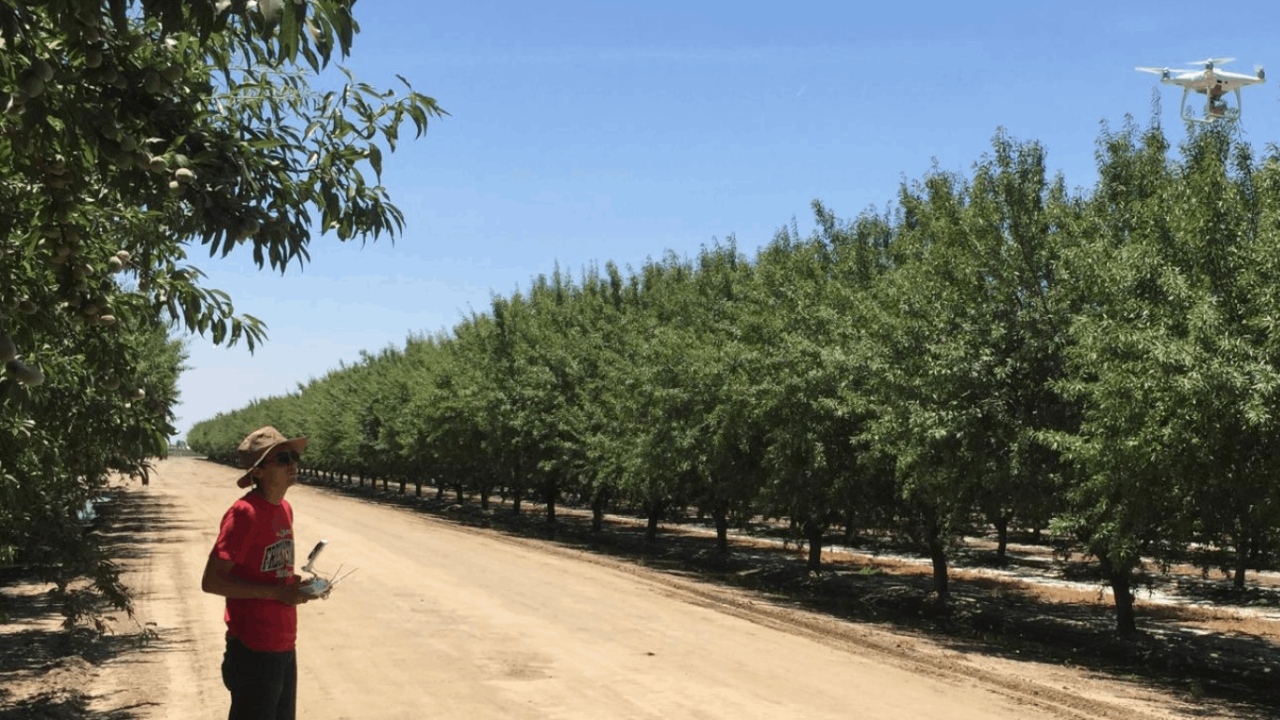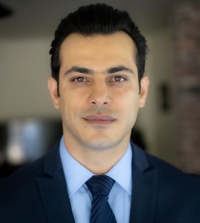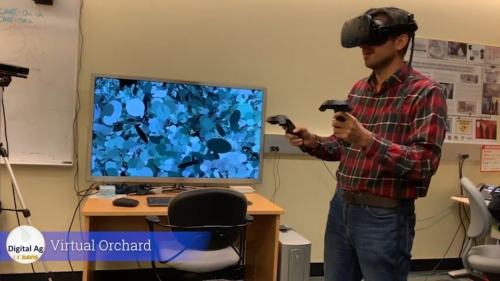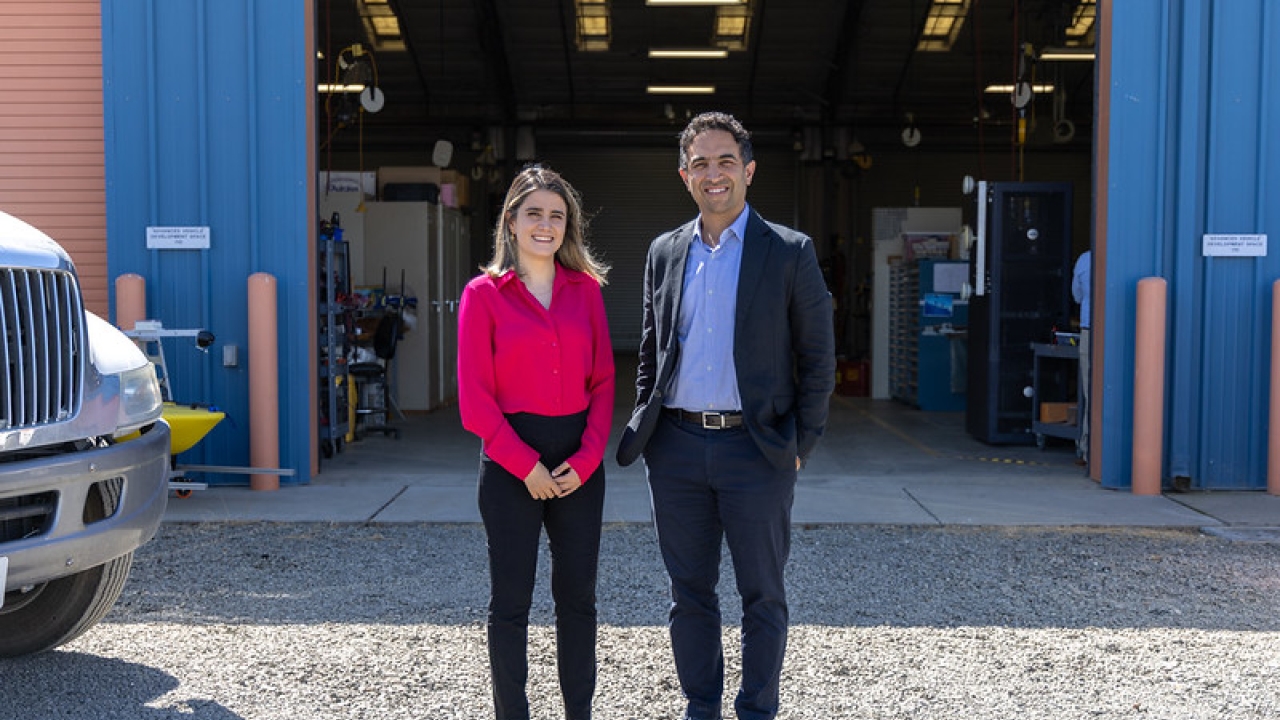
Agriculture Goes Digital
The UC Davis Digital Agriculture Lab uses cutting edge sensing and mechanization technology to help growers get the most out of their crops
To produce food for a growing population and a changing climate, growers need to understand their crops on an individual level.
Irrigating an entire orchard or vineyard with the same level of water and nutrients may make some plants excel at producing nuts or fruit, while others might be getting more than they need. Not knowing this can lead to disappointing crop yields, wasted water, high costs and long-term damage to both the plants and the environment—all of which can devastate a grower.

The UC Davis Digital Agriculture Laboratory sits at the intersection of agriculture and digital technology. Led by biological and agricultural engineering assistant professor Alireza Pourreza, the lab works directly with growers to develop and deploy technology that gives them the information they need to better understand their plants and navigate our changing climate.
“The goal is to develop data-driven solutions for growers on a high-precision and per-plant basis,” he said. “This will simultaneously give them an insight into the health and productivity of their crops, where they are losing money and how they can improve management to increase yield and reduce the environmental impact.”
A Virtual Orchard
One of the lab’s most beneficial projects is helping growers predict how much their crops will produce, which is largely determined by how well each plant receives and absorbs sunlight.
“If we understand how much light would be available to each plant during the season, we can estimate photosynthesis and the amount of yield,” said Pourreza.
“If we do this early in the season, we can manage each tree based on its capability and needs.”
To do this, the lab uses one of its hallmark innovations—the virtual orchard. Using drone imaging data, the team can create highly-detailed 3D reconstructions of an entire orchard in virtual reality. This allows them to examine data on individual plants in detail and run simulations.
In a recent project, the team modeled the mid-season sun position for an almond orchard to model light absorption by each tree’s canopy. This helped the growers predict how much each tree would produce so they could manage each zone of trees differently, as well as optimize pruning to improve the canopy’s ability to absorb sunlight.
Recently, the team has worked to expand the virtual orchard’s success by designing a complementary web app. The app lets growers easily view and interact with their simulated orchards and Digital Ag Lab’s data analytics and filter results to look at specific plants to understand the conditions that will make them grow best.
Seeing Plants in a New Light
For many of California’s crops, the best way to collect information is via drone. Drones are versatile because researchers can mount several different devices on them to take high-resolution images and measurements, including thermal, RGB, multispectral and hyperspectral cameras.
According to Pourreza, many growers now either own or rent drones and he expects the number to continue rising.
“With the availability of drones and the price dropping every day, it’s more accessible to growers and it’s a great tool for monitoring,” he said.
One of the most powerful sensing tools the team has is hyperspectral imaging. Hyperspectral imaging covers more than 300 wavelengths of light and captures things that humans can’t see with their eyes. These “hidden” wavelengths contain detailed information on each plant, such as how effectively it’s conducting photosynthesis or whether it’s sick—one of the leading causes of low yield.

One of the projects Digital Agriculture Lab Ph.D. candidate Hamid Jafarbiglu has enjoyed the most is identifying walnut trees that are infected with root lesion nematodes (RLN), tiny worms in the soil that attack tree roots. RLN infestation is a common problem in California, and young trees are the most vulnerable. It can leave growers with no other option than to re-plant the entire orchard. However, when infected, the trees give off signals that can be seen through hyperspectral imaging.
“If you compare the spectral information from a healthy tree and a tree that is affected by nematodes, you can see that there are very subtle differences and you can use those subtle differences—we call them ‘spectral features’—to separate affected and healthy trees,” said Jafarbiglu.
Identifying these spectral features help growers take action on infected plants before it becomes a major problem.
Combating Climate Change
The Digital Agriculture Lab’s technology is poised to play an important role in combating climate change, where efficiency and sensitivity to the environment are critical.
An example comes from the lab’s agricultural mechanization work. Almond growers need to get as large of a pesticide coverage as possible on their plants, but spraying too much means spraying toxic droplets that can pollute the air and drift to nearby schools or residential areas.
So, the team designed and built a spray backstop—an orchard sprayer attachment topped with a screen that looks like a large, wide umbrella. The screen is just tall enough to go over the treetops, and it blocks drifting spray droplets before they are released into the air. Pourreza says the growers were thrilled and he sees the potential for the idea to be commercialized.
Sensing technology can also be used to accurately measure different crop phenotypes—a plant’s traits like size, shape and color that are influenced by both genetics and the environment. With sensing, researchers can find the best genotype for different environments—such as those that are resistant to droughts or nematodes—and introduce them to the growers.
“If we continue growing the plants that we already have, rising temperatures or cold weather in the beginning of the spring might cause us to lose all we have in our orchard,” said Jafarbiglu. “But if we find the most resistant plant with this analysis, we can reach food security."
Optimization is also key to combating climate change. With optimal water and nutrient use on a per-plant basis, growers can save resources and prevent the detrimental effects of over-watering, such as dead soil and contamination of underground water resources.
“Because we are dealing with climate change, we need to be prepared to adapt,” said Pourreza. “If we do not have accurate and timely information about agricultural production, we may lose crops due to some unexpected event. Using large-scale monitoring, we can prevent that.”
This story was featured in the Fall 2021 issue of Engineering Progress.




